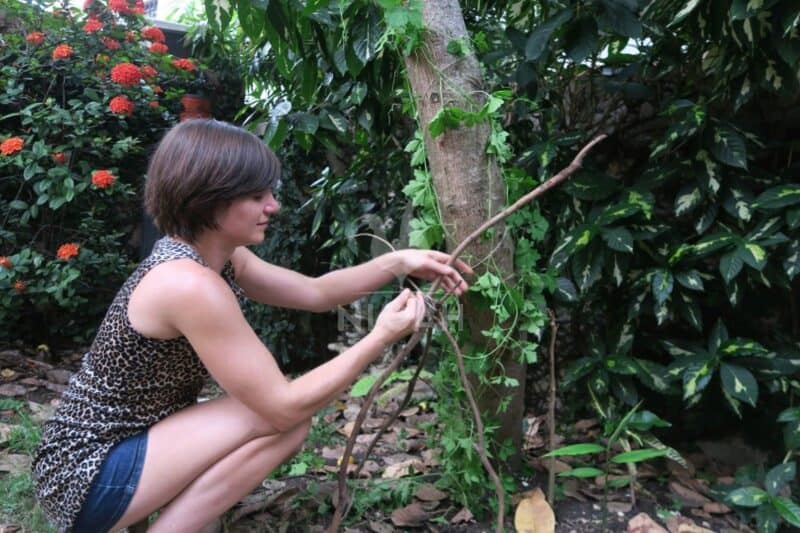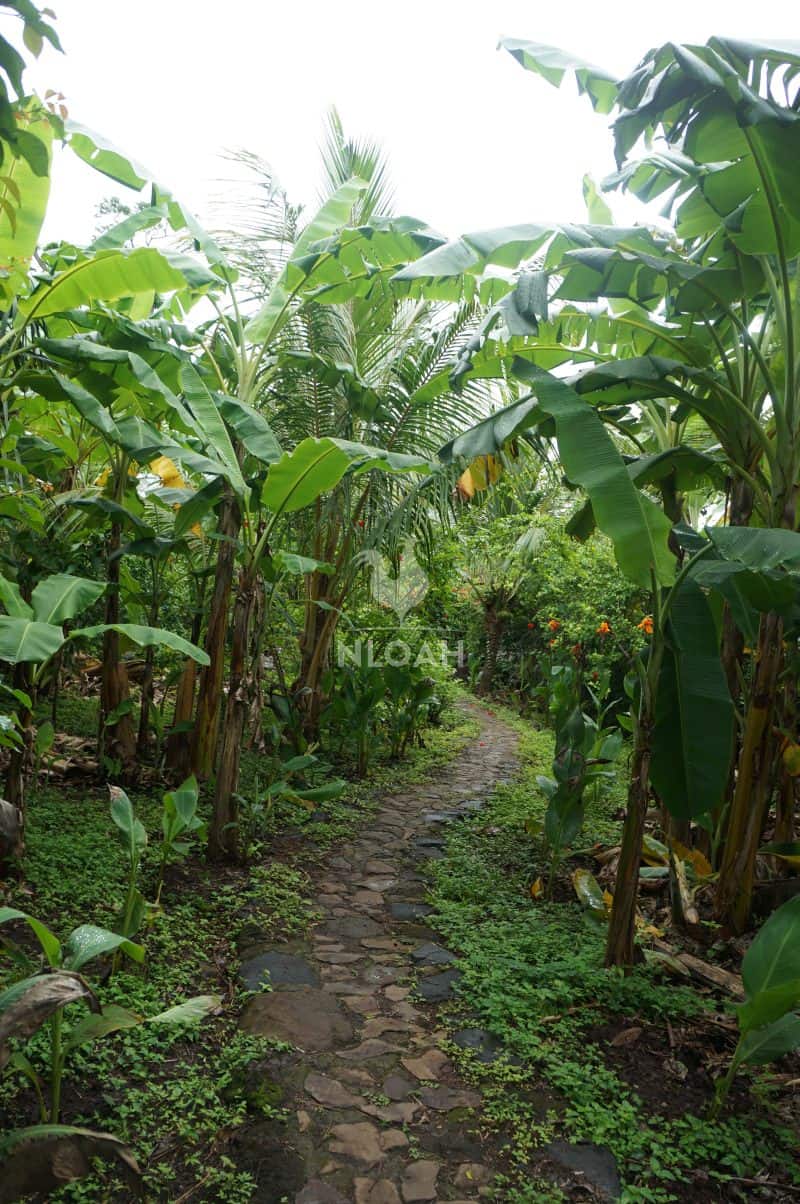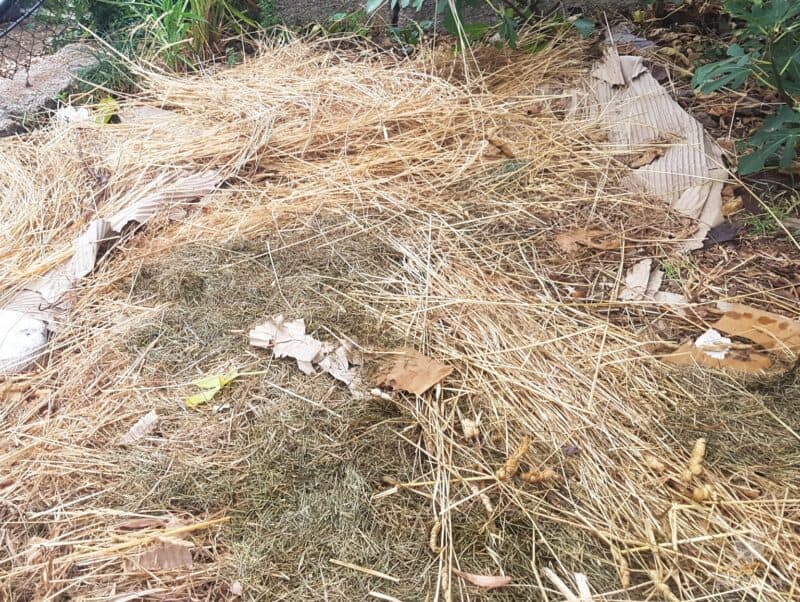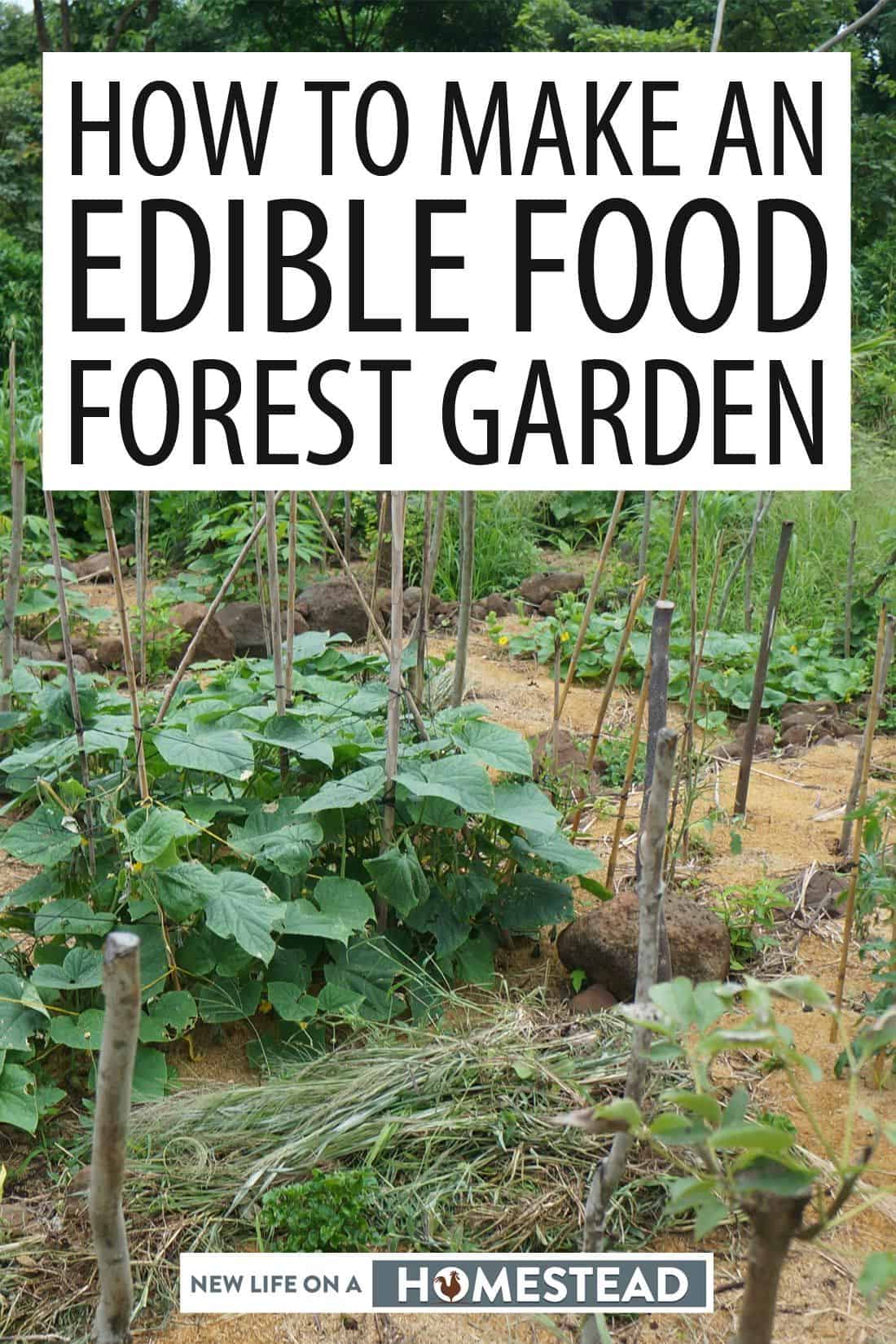What if you could grow a garden that not only provided nourishment, but also required minimal upkeep? What if that garden attracted pollinators, created wildlife habitat, and was beautiful to look at? You would do it in an instant, wouldn’t you?
With an edible forest garden, that dream is a reality.

What is a food forest, you might ask?
A forest garden isn’t exactly a forest, but it isn’t exactly a garden, either. It’s a combination of the two, serving as equal parts forest, orchard, and vegetable garden.
It is a planting method that takes into consideration the beneficial relationships between plants, just like any other woodland ecosystem does. The resulting garden is beautiful and incredibly productive – and can be done with minimal space.
There are three basic layers in an edible forest garden: groundcover, shrub, and tree. However, you can also add additional ones, with up to seven potential layers.
In this article, I’ll tell you everything you need to know if you are interested in learning how to make an edible forest garden.
Why You Should Grow an Edible Forest Garden
There are several key benefits to growing an edible forest garden.
The first is that it can work well with any kind of landscape. It doesn’t matter what your climate is like, what your topography is like, or what your sunlight exposure is like. Even if you have a partially shaded lawn, you can build a forest garden.
When you build a forest garden, you can take advantage of the landscape you have, even by planting “on the edge.” You can plant on the boundary where two ecosystems meet, which will help both ecosystems share resources with each other.
Growing a forest garden isn’t just about growing food, either. While most people grow their forest gardens to feed themselves and their families, these gardens can also be grown to provide timber, dyes, or even cosmetics.
The goal of planting a food forest is that you are planting a garden in which every selected plant is chosen to complement the next.
A food forest does not have to be huge – you can plant it even on a tiny postage stamp of a property. But the key is to be strategic – everything provides something for something else.
Basic Principles of an Edible Forest Garden
According to Tomas Remiarz, the author of Forest Gardening in Practice, “A forest garden is a place where nature and people meet halfway, between the canopy of trees and the soil underfoot.
It doesn’t have to look like a forest – what’s important is that natural processes are allowed to unfold, to the benefit of plants, people and other creatures. The result is an edible ecosystem.”
An edible forest garden is also a key component and principle of permaculture. Permaculture is a term first developed by David Holmgren and Bill Mollison in 1974, and is defined as, “the conscious design and maintenance of agriculturally productive ecosystems which have the diversity, stability, and resilience of natural ecosystems.”
The edible forest garden is one of the best-known and easiest-to-implement methods of permaculture design. It is meant to mimic the function and structure of a natural woodland but in a more usable, edible way.
With low input, you can get a high yield and help to support an ecologically-friendly natural environment – what better expression of key permaculture principles could there possibly be?
There are several key principles you’ll want to consider when designing your forest garden. Doing so is equal parts science and art – you’ll put plants together in woodland-like patterns to help create relationships that are mutually beneficial.

Principle 1: Focus on Diversity
There’s no better buzzword to connect to the idea of an edible forest garden thean biodiversity. In the edible forest garden, you as a human are just one species among many.
While the main role you will play is in choosing plant species and varieties, you’ll want to choose ones that interact well with a myriad of animals, fungi, and bacteria.
Focus on structural diversity, too. A forest garden shouldn’t be solely horizontal (like a heath or meadow) but should also be vertical. This will allow you to grow the most productive, ecologically-friendly garden in the least amount of space.
The garden should have functional diversity, too. A garden might produce fertility, bee forage, and beauty along with providing food and medicine. It should have diversity of location, taking advantage of the land’s vegetation, light, water, slopes, and sunlight.
Principle 2: Observe
Take the time to observe and interact with the site. Wait as long as you can to monitor the land before you plan your garden. That way, you know which plants will best be planted where.
A forest garden is much more permanent than any other kind of garden, so it’s important that you plan carefully.
Principle 3: Minimal Effort
Forest gardens should use self-seeding, perennial plants that require minimal tending. There will be no tilling, fertilizing, or weeding. In the food forest, the garden takes care of itself.
Principle 4: Responsible Use of Resources
A productive edible forest garden takes advantage of natural resources while respecting them at the same time. It should require no use of artificial pesticides, herbicides, or fertilizers.
It should improve soil health rather than the other way around, allowing worms and other creatures to live freely in the soil. It should also produce no waste, keeping all energy (from fallen leaves to prunings) in the system.
Principle 5: Decide on a Group Structure
An edible forest may require a large “tribe” of people. To thrive, a forest garden will also include a diversity of people – both in terms of their backgrounds, roles, and personalities. All skills are welcome!
Principle 6: Go Beyond the Edge and Learn
Your food forest should not be isolated from the world. There does not need to be a clear boundary between your food forest and the rest of the world. Growth continues to happen on those edges, both physical and metaphorical.
Every forest garden offers a great learning opportunity for those involved.
Choosing Plants For Your Forest Garden
The Layers
When choosing plants for your forest garden, the first thing you need to consider is the layers.
I’ll break down the individual layers later on in this article, but start by making a chart of all of the layers that need to be included so you can jot down ideas for plants you’d like to include in each one.
The Land
Design your forest garden in accordance with your specific site. A food forest, to be successful, must always be designed to suit its climate, conditions, and environment. Growing a food forest in a tropical environment will look much different than growing one in Nova Scotia.
You might worry that planting trees in your garden will create too much shade, cutting out all of your light and making your garden less productive.
However, the key is to develop a plan for your food forest that incorporates trees, but also takes into consideration the more open parts of the landscape.
The People
Who will be involved in planting and tending to your edible forest garden? While a food forest requires minimal work, it’s important to consider who the garden will be feeding so that you can plant appropriate amounts of food.
Light and Shade
Track the sun exposure in your food forest, ideally by making a sun map during the summer months. Determine how the sun hits your garden at various times of the day to get an idea of which areas are fully shaded, partially shaded, or fully-lit.
Access
Plan pathways through your food forest ahead of time. That way, you won’t be faced with a forest garden that is impossible to navigate after planting, when the plants included in it are mature.
Competition and Cooperation
The key to planting a successful food forest is to think holistically, from the design to the patterns to all the details.
When you plant a food forest, you need to remember that a forest is not individual plants, fungi, and animals – it’s all of these components wrapped together. Therefore, you need to think holistically to establish an ecosystem in your garden.
Carefully consider which plants will work well together – and which ones will compete. Remember the companion planting pairings you already know so well, and consider trying new ones based on what you know about those plants.
When you grow in a forest garden, you will be creating, in essence, what is referred to as a “guild” of plants. The plants are chosen to complement and aid each other so that they can do all of the following things:
- Draw nutrients from the soil
- Improve environmental conditions (like providing shade or ground cover to reduce water loss)
- Fix nitrogen
- Attract pollinators and predatory insects
- Repel or distract various pest species
Succession
Given enough time, your food forest should evolve. You won’t necessarily be able to harvest fruits and nuts from your food forest in the first year, but you should be able to harvest some herbaceous plants or ground covers.
Given true succession, you will eventually be able to harvest long term resources like timber, too. Plan these features into your food forest and think long term rather than short term.
Wildlife
Everything is connected in a forest garden, and while a traditional garden might contain all kinds of barriers to keep wildlife out, that is not necessary in a food forest.
Everything that visits your garden is an important part of the food forest. Create and plan your food forest with local wildlife in mind.
Soil
When designing your food forest, remember that you will also need to consider all of these elements that you can’t actually see. Pay attention to the soil – and I don’t mean by adding tons of fertilizers before you plant.
What this means is that you should make sure all soil biota, from bacteria to fungi and other microorganisms, are accounted for.
These garden helpers will help you do your work, even though you can’t see them. You can boost them by planting certain pairings of individual plants that will do the work for you.
For example, deciduous trees will drop their trees in the fall. Leave them there. The leaves will nourish the soil. Planting legumes, like beans, will fix nitrogen in the soil. This will benefit the plants that are grown around them.
Other Resources to Add to Maintain Your Forest Garden
A food forest needs to contain a few other resources for it to be self-sustaining.
Nutrients
Plant wisely, and plant thickly so that groundcovers can shade the soil and suppress weeds (reducing erosion and the loss of nutrients).
Use nitrogen-accumulating and nitrogen-fixing plants, along with chop and drop techniques, to help keep wastes in the land and accumulate nutrients. That way, you won’t have to use synthetic fertilizers.

Mulch
Any permaculture garden should use a green mulch to control weeds and help retain water and soil nutrients. When you first plant your garden, consider seeding some common green mulches with your groundcovers, like comfrey, chives, dandelion, yarrow, parsley, and rhubarb.
Water
A food forest should more or less take care of itself when it comes to water, too. There are a few ways you can reduce your need to irrigate the food forest.
For example, you can incorporate several ground-shaping techniques to keep water on the site (such as swales), and design for placement of plants that creates microclimates, water resources, and even windbreaks.
Pest and Weed Control
For the most part, the plants that you grow in your edible food forest should take care of this part for you. Consider growing perennial plants that offer natural pest and weed control – a few ideas will be given below.
Over time, your garden should be filled with natural pest controllers like praying mantises, ladybugs, predatory wasps, and other beneficial insects.
Creating Your Food Forest: Start By Laying Out Your Forest Garden
To create your own food forest, it helps to first make a list of the characteristics you want your edible food forest to contain according to all the factors I mentioned above. Then, you can start planning your food forest, starting first with the “largest” layer – trees.
Layer 1: Trees
Food forest design begins with the trees. Choosing the right trees will help you establish the perfect forest garden. You will want to consider the following characteristics when you choose your trees:
- Where you live
- Growing conditions
- Your particular tastes
- Soil type, fertility, and pH
- Amount of space available (consider the eventual size and spread of the tree)
- The desired yield
Some common food forest trees include apples, cherries, hazelnuts, plums, and pears.
Depending on how many layers you’d like your food forest to have, know that the tree layer can actually be broken down into two separate layers – it will contain a canopy layer with taller fruit and/or nut trees, along with a lower layer of dwarf fruit and/or nut trees.
Layer 2: Shrubs
The next layer to consider is the shrub layer. You will want to plant food-producing shrubs, bushes, and canes, such as gooseberries, currants, raspberries, blackberries, elderberries, or blueberries.
Some other plants you can grow here include:
- Bamboo
- Serviceberry
- Siberian pea shrub
- Rose
- Butterfly bush
Layer 3: Herbaceous Edibles
You can occasionally plant annual vegetables in an edible forest garden, but a true forest garden will hang its hat primarily on perennial veggies.
Think you don’t have a lot of options? Think again. There are all kinds of perennial vegetables that can be grown in this layer, including:
- Perennial cabbages (NineStar broccoli, Ewiger kohl, Daubenton’s kale)
- Edible weeds (chickweed, fat hen, comfrey, Good King Henry)
- Perennial onions and garlic
- Edible perennials that are usually grown for shade or ornamentals like hostas
Consider growing other plants in this layer, too, like culinary and medicinal herbs, pollinator-friendly plants, and companion plants.
Layer 4: Groundcover Layer
This next layer is planted to serve as a living mulch. These plants should be primarily those that are edible, but you can also grow pollinator-friendly plants, too.
Some options to consider include:
- Strawberries
- Nasturtium
- Clover
- Creeping thyme
- Ajuga
- Verbena
- Phlox
Layer 5: Rhizosphere
In the rhizosphere layer, you will plant edible plants that consist primarily of root crops. Some options include:
- Jerusalem artichokes
- Potatoes
- Daikon
Consider planting root crops that are easy to dig, and are shallow-rooted to prevent you from having to disturb other plants when you dig.
Layer 6: Climbing Layer
The last layer is a climbing layer that takes advantage of your vertical space. Grow vining crops here, such as:
- Kiwifruit
- Grapes
- Passionflower
- Hops
- Vining berries
- Cucumber
- Squash
- Melons
- Honeysuckle
- Trumpet flower
As you can see, the plants in this layer (as with all other layers) don’t have to be perennial – squashes and cucumbers are not, for example. However, whichever vines you choose, make sure they are not invasive or strangling.
Maintaining Your Edible Forest Garden
There are very few steps you need to take to maintain your edible food forest. Most of these steps will only be necessary immediately after planting, as your forest is getting itself established.
The first step is in keeping weeds down. Ideally, when you first start your forest, you will have cleared all the weeds and put down mulch and cover crops to suppress them. Once a month during the growing season, spend some time chopping and dropping annual weeds.
If you notice a bad outbreak of weeds, you may want to add more mulch – or you can compost the weeds you chop and drop. Just remember, nature is not fond of bare soil, so you’ll need to keep on top of weeds as your plants are getting themselves established.
Some food forest plants may require pruning, too. For example, some kinds of fruit trees must be pruned to stay productive. Over time, you might also want to add more plants to continue the productivity of your food forest.
Grow a Food Forest to Benefit You, Your Family, and the Environment
As you can see, there are so many reasons to consider growing a food forest. As the climate crisis worsens, it’s essential that we learn how to work with nature and create a more sustainable food system.
Use your space to the fullest, where you can provide an abundance of food for minimal effort and increase the biodiversity of your garden.
A food forest can help improve the ability of your garden to capture carbon, helping to fight climate change. It also protects and improves the soil, wildlife, and ecosystem.
Sure, a food forest does take some time to set up and plan – but no more so than any other type of garden. After it’s established, though, it will be largely self-sustaining – all you’ll need to do is harvest the produce and enjoy the yields.
Plus, let’s not forget that growing a food forest will give you a wonderful space to relax, recreate, and unwind – you’ll be able to enjoy your food forest for years to come.


Rebekah is a high-school English teacher n New York, where she lives on a 22 acre homestead. She raises and grows chickens, bees, and veggies such as zucchini (among other things).

This comes at a good time with good info. I was planning on ordering some trees for our property today. Its a mix of different zones (ag, forest, yard, swamp, pasture). I’m planning on ordering maple, hickory, apricot, apple and black cherry trees. Next year a different variety…maybe Norwegian Red Pine? Last year we planted many edible trees and bushes too. Planting fruit/nut trees seems like a 10-25 yr long term healthy food plan for my family.